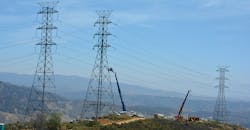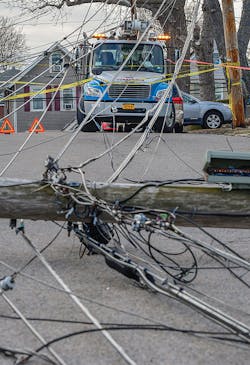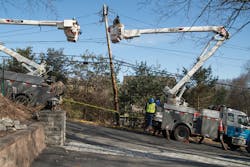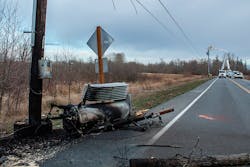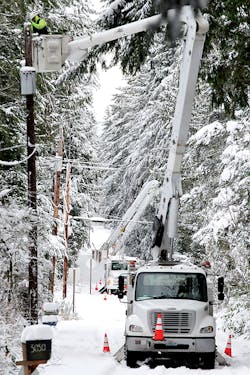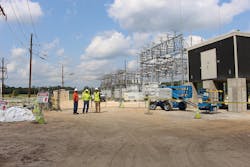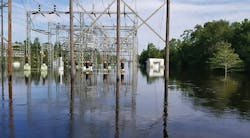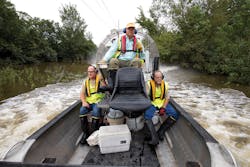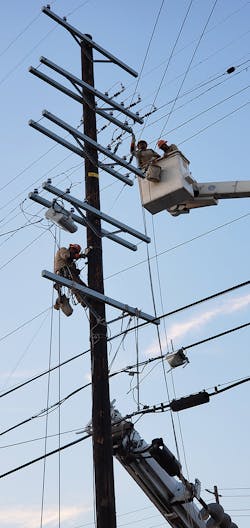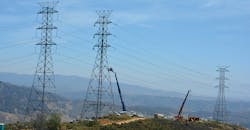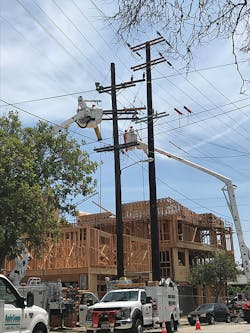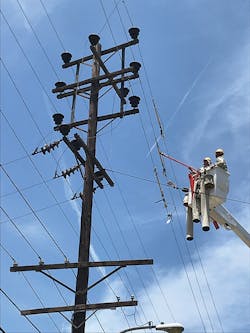Seven years ago, Hurricane Sandy, combined with a nor’easter that struck the next week, caused 1.1 million customer outages. Following the storms, Con Edison focused on ramping up its plans to harden its system.
“Following Superstorm Sandy, it was clear to us that weather patterns were fundamentally changing,” said Shakira Wilson, vice president, Bronx-Westchester Electric Operations. “Severe weather events were becoming more frequent and destructive. To protect our customers and equipment, we invested $1 billion over four years to fortify our energy delivery systems in New York City and Westchester County.”
Con Edison is not alone. Other electric utilities are also fortifying their systems, boosting resiliency and improving reliability. As line workers install stronger, more weather-resistant poles, wire and other types of infrastructure, they are helping utilities to keep their customers’ lights shining brightly.
Building a Stronger System: Con Edison
Tropical force winds wiped out infrastructure and caused massive power outages in Westchester County, New York, last year. In response, Con Edison’s line workers rebuilt the system to be stronger and more resilient to future severe weather events.
“The March 2018 storms—Riley and Quinn—were devastating to our equipment and customers,” Wilson said. “They combined to cause nearly 210,000 customer outages, second in our history only to Superstorm Sandy.”
Westchester County reported 155,000 service outages, which not only resulted in tremendous personal hardship for its 355,000 customers, but also led to more than 7,000 rebuild and repair jobs, Wilson said.
“It was a virtual rebuild of our overhead electric-delivery system in Westchester County,” Wilson said. “By comparison, Hurricane Irene—which struck in August 2011—caused approximately 204,000 customer power outages, but required only 2,500 repair jobs.”
During the storms, Con Edison learned that trees were at the root of the damage. According to a survey, however, about 75% of tree damage came from trees outside of the Con Edison right-of-way. Less than 10% of the damage was caused by tree-crown failures, indicating that the utility’s tree trimming program was effective, said Thomas Zazzarino, a section manager in Bronx-Westchester Electric operations.
The survey, which covered 12 circuits including 140 damage sites, concluded that the outages were primarily caused by large trees that were uprooted and failed at the trunk outside of the tree trimming area. Also, the survey found that 93.6% of the failures were caused by trees within 50 ft of electrical wires, and 77% of the investigated outages were caused by privately owned trees outside the regular maintenance right of way.
Even so, Con Edison opted to be proactive, rather than reactive, in future severe weather events. The utility recently invested $2 million in a program to remove damaged or diseased trees and present a potential hazard in Westchester County free of charge for homeowners. So far, the arborists have identified more than 1,600 trees as hazardous, and more than 800 homeowners have granted Con Edison permission to have its licensed tree-service contractors remove more than 700 trees.
“The response has been excellent,” Zazzarino said. “We think it will reduce power outages caused by trees and branches falling on overhead lines.”
In addition, following the March 2018 storms, Con Edison announced an additional investment of $100 million in Westchester County to cover the ongoing cost of installing stronger poles and wires as well as smart switches, which limit the number of outages that occur when a tree hits a line.
Over time, the company expects its storm fortification to continue to evolve. Con Edison is working with vendors, peer utilities and industry research groups to identify the best technologies to further harden the infrastructure. Case in point: the company is installing TripSavers, which provide additional opportunity for intermittent faults to clear on fused spurs. Con Edison is also installing break-away services that help the company to reduce repair times and is working with customers and municipalities to facilitate installation of microgrids. Finally, the line workers are installing aerial cable and Hendrix cable, which incorporate a steel messenger, greater dielectric strength and a smaller footprint to reduce the likelihood of damage when a tree does come into contact with infrastructure.
In many cases, existing technologies provide significant returns for the company’s investment. To dramatically reduce the number of affected customers, Con Edison is installing more automated sectionalizing switches, ties and fuses to limit the number of customer outages caused by a single point of damage. Dividing its recloser loops (FLISR technologies) into smaller units also reduces the number of customers impacted and the likelihood of an interruption. In addition, selectively undergrounding feeds or installing automatic transfer switches for critical customers or load centers has helped to avoid outage to hospitals, nursing homes and shopping centers, minimizing the disruption to Con Edison’s customers during an event.
As Con Edison is focusing on hardening its system, the utility’s line workers play an integral role. Its workers and contract employees are providing valuable insight about how to best improve the system and the service the utility provides to its customers while they maintain and upgrade the overhead electric delivery system.
“Our employees are our greatest asset,” said Troy Devries, a general manager in Bronx-Westchester Electric Operations. “They know where the problems are and are not shy about letting us know about them.”
Through its hardening program, Con Edison has tried to be proactive and use data to determine which improvements have the greatest impact, Wilson said.
“We estimate that in a typical event, our post-Sandy improvements reduce outages by 15 to 20%,” Wilson said. “That has amounted to about 500,000 outages avoided since Sandy.”
Targeting Problem Areas: Puget Sound Energy
In just over one month, Puget Sound Energy (PSE) was hit with three wind and snow storms, which inflicted both damage and power outages. Since that time, the utility has placed a strong emphasis on investing in reliability improvements. By targeting its worst-performing circuits, it can harden the systems and make the grid more resilient.
For example, PSE’s line workers have installed tree wire on the circuit feeders to withstand vegetation- and animal-related outages. Following implementation, areas where tree wire has been installed see a dramatic drop in the number of interruptions caused by tree limbs — one of the major contributors to electric service interruptions in PSE’s service territory, particularly during storms.
In addition, PSE’s crews have also made other reliability investments such as distribution automation, which helps to reduce the impact of electric system interruptions. The technology minimizes the number of sustained customer interruptions through automatic fault detection, isolation and restoration. The automatic fault detection and isolation functionality has resulted in reduced patrol times by PSE’s line workers because the faulted and de-energized section of the system is minimized.
In addition, the company is also undergrounding certain high-risk sections prone to full tree fall-in failures, installing more distribution automation across the system and proactively replacing aging infrastructure like high-risk cable.
“These have proven to be effective at helping to keep more customers in service over time,” said Jens Nedrud, PSE manager of system planning. “Specifically the work done on our worst performing circuits in 2018 resulted in a savings of almost nine SAIDI minutes across those 135 circuits, which was a 15% year-over-year improvement.”
To identify specific reliability and resiliency issues, PSE launched a targeted Reliability Root Cause Analysis program, which involves a variety of different departments including operations, distribution planning, engineering and vegetation management. This team focuses on performing in-depth, post-event analysis of major outages during blue-sky conditions and storms.
So far, the program has identified opportunities to improve reliability-related activities like system design, work practices and operational and maintenance activities. Looking forward, the program will continue to increase awareness and knowledge of key reliability factors across the organization and help PSE to identify specific system improvement opportunities.
PSE’s line workers are participating in the design and implementation of new transmission and distribution smart grid technologies by serving on committees. By engaging the field workforce, PSE’s management strives to increase field safety and improve the design from an operational perspective.
“Engaging our line workers in this way has delivered significant value and has led to project implementations with greater safety, successful change management and a stronger operational design,” said Dan Koch, PSE director of operations. “This collaboration has proven to be a win-win success by involving the key departments, building relationships and trust and achieving a result that places safety first, establishes clear direction and provides a feeling of accomplishment and belonging to all involved.”
PSE’s line workers are engaged in the design, implementation and overall change management of new technology, which includes front-of-the-meter and behind-the-meter battery storage projects. Koch said this engagement is critical to ensure that a field safety and operational perspective is being properly considered in the development of the design, maintenance and operating response procedures.
The construction activities for PSE’s reliability investment work is accomplished by regional transmission and distribution line crews owned and operated by Potelco, PSE’s service provider. These regional line crews accomplish all of PSE’s planned and unplanned work including, but not limited to: new customer construction, unplanned outage and public safety emergencies, underground cable replacement projects, pole replacements, tree-wire installations, conductor upgrades and overhead-to-underground conversions. Meanwhile, all emergent and customer-requested line work that does not require a full construction line crew with equipment is handled by PSE’s team of electric first response journeyman lineworkers.
As PSE is deploying new technologies out into the field, the utility is continuously training its line workers. For example, the utility has invested in lateral fuse-saving devices and distribution automation schemes. These devices will automatically detect a system fault, isolate and close in from other sources to restore the most customers possible.
“Lineman training on these devices is crucial to ensure the safest working conditions when responding to planned and unplanned outages, since restoration of power at that site may be abnormally fed upon their arrival,” Koch said. “It is critical that all utility operations personnel fully understand how these new technologies will impact clearing and switching procedures necessary to safely work on the system.”
Minimizing Future Flooding Impacts: Entergy Texas
Hurricane Harvey inflicted power outages to 41% of Entergy Texas’ customers and impacted 17 substations. The storm, which lasted for eight straight days in the summer of 2017, flooded pad-mount transformers and underground equipment like reclosers, regulators, capacitor controls and meters on houses and businesses. From a transmission and substation damage perspective, Hurricane Harvey was not a typical hurricane for Entergy, said Todd Gallagher, senior manager of the Texas grid for Entergy Texas, Inc.
“When thinking of hurricane damage and restoration, we primarily think of wind-induced damage. However, Entergy’s damage from wind was minimal to the transmission system in Harvey,” Gallagher said. “The most significant damages we experienced were attributed to the floodwaters. As the waters flooded several of our substations, damage was incurred to not only station equipment such as motor operators and breakers, but more critically to the control houses within the stations.”
Following the flooding, the restoration of this damage included not only repair or replacement of destroyed equipment, but also mitigation of health and safety hazards including mold inside the facilities.
In addition, Entergy also elevated control houses at six critical substations to a height well above the Hurricane Harvey and other historical flood levels (see sidebar). On its transmission system, Entergy is building its infrastructure using the extreme winds as defined in the latest edition of the National Electrical Safety Code for new construction or rebuilt facilities.
Line workers are replacing wood transmission poles with concrete or steel if the material is available in a timely manner. The crews must also install steel or concrete for new facilities, during complete transmission line rebuilds or new construction within 20 miles of the Gulf Coast and in the conversion of interstate crossings.
Meanwhile, on its distribution system, Entergy is installing minimum Class 3 poles on trunk feeders for new construction or replacement in certain service areas, expanding installation of storm guys and converting wood pole interstate crossings with steel poles. The company is also deploying a communications system as part of the advanced meter infrastructure project.
“This will allow for distribution automation and real-time monitoring and control of devices in the field, allowing us to know where it has problems and restore power as quickly as possible,” said David Richard, senior manager of operations and safety for Entergy Texas, Inc.
Upgrading Infrastructure: Los Angeles Department of Water & Power
In Los Angeles, weather-related storms that affect Los Angeles Department of Water & Power (LADWP)’s infrastructure often involve heavy rain, strong winds and intense heat.
For example, last July, the City of Los Angeles experienced one of the hottest days ever recorded, leading to a record-breaking peak energy demand. The sudden and extreme heat overloaded underground cables and splices, which accounted for 60% of the outages recorded during the heat storm. The power outages affected 4,000 customers at 4 p.m. and then soared to 46,000 later on that same day.
Rain and wind are also problematic, and due to the aged infrastructure and materials like old wood poles, pins and crossarms, these types of storms cause more structural damage to the overhead system. Palm trees are also often at the root of the power outages in heavy winds and pelting rain.
“Palm trees are quite common in Southern California and are often found on both public and private properties and grow to heights that exceed the average power pole,” said Dan Barnes of LADWP. “Dead fronds from palm trees hold a tremendous amount of moisture. If dislodged during a rain or wind storm, the fronds can wreak havoc on our system.”
LADWP invests about $24 million per year in its vegetation management program. As part of its proactive approach, it conducts annual zone circuit patrols and prunes trees to maintain clearance between vegetation and power system infrastructure such as conductors.
Vegetation management not only improves reliability by minimizing tree-related outages, but it also ensures public safety. LADWP’s arborists and tree surgeons are specifically trained to inspect, track and maintain vegetation growth in various habitats. Additionally, LADWP conducts spot inspections for other LADWP groups and ratepayers on an as-needed basis.
As part of its proactive power equipment inspections, LADWP identifies needed repairs ranging from a broken crossarm to an abnormal circuit. During the 2017-2018 fiscal year, LADWP crews completed repairs on almost 11,000 jobs, which marked a 20 percent increase from the previous year.
Also, power system engineers, construction crews and system operators continue to work on identifying heavily loaded circuits that need relief and associated equipment upgrades at various locations. Through its Power System Reliability Program (PSRP), LADWP’s line workers are swapping out poles, cross arms, transformers, overhead circuits and underground cable on the distribution system and upgrading transmission, substation and generation equipment.
The program provides a blueprint for ensuring continued reliable energy service for future generations of Los Angeles residents. LADWP implemented the PSRP through a two-pronged approach — rebuilding infrastructure and proactive maintenance — and will invest more than $1 billion in the program over the next five to 15 years. The program is funded through a power reliability surcharge.
The PSRP, a comprehensive asset assessment and rehabilitation program, covers four major asset classes: generation, transmission, substation and distribution. By focusing on aging and critical infrastructure as well as establishing inspection and replacement cycles, the PSRP helps LADWP to provide continued reliability for its customers.
As part of its hardening program, the company is making its system more reliable and resilient. For example, LADWP is building to the standards for wind loading and using alternative materials like steel, fiberglass and ductile iron instead of wood poles. In addition, the line workers are removing lead and installing synthetic cable.
Every newly installed pole is individually designed based on every attachment to that pole, including the other utilities’ lines and equipment, to withstand the possible wind loading in that area. Materials and construction standards are adjusted accordingly so all new construction is more robust thus, improving reliability.
All of the LADWP line workers take part in upgrading and hardening the system, and the trouble crew, cable splicers and electrical distribution mechanics play a role as well. The department also hires specialized contractors to handle the overhead line and cable replacement work while the in-house crews focus on system upgrades and new business projects.
The hardening program reduces the SAIDI and SAIFI numbers and provides a reliable power system for the rate payers in Los Angeles. It also helps the company to weather wind and heat storms, wildfires and earthquakes.
“Improving our reliability in storm conditions involves a very aggressive underground cable, overhead conductor and transformer replacement program to relieve the overloaded distribution system during excessive heat storms,” Barnes said. “For wind and rain incidents, we rely on our aggressive vegetation management program as well as the use of alternative materials such as steel poles and fiberglass crossarms and modified construction specifications to increase the resiliency of our system.”
The industry has created more resilient materials from poles to crossarms to hardware that will extend the life of new infrastructure. By installing larger and stronger 4.8 kV conductors, LADWP can provide more protection for new and existing construction.
“We are always looking at materials that will last longer and are easier for us to install and maintain,” Barnes said. ”LADWP is committed to providing reliable power and is fully aware of the risks extreme changes in climate pose and as a result is exploring innovative ways and methods to address these new challenges proactively.”
Sidebar: Seven Strategies to Strengthen a System
PSE focuses on building, operating and maintaining an electric power grid that is safe, reliable, resilient, smart, flexible and green. To this end, the utility is actively investing in the following initiatives, many of which involved line workers, to provide a stronger grid.
- Overhead tree wire projects. One of PSE’s biggest challenges for grid resiliency is hardening its electric infrastructure against vegetation-related outages. The utility has invested heavily in a rigorous pole inspection and replacement program to ensure structural strength for its overhead system and minimize the number of poles damaged or broken due to vegetation-related issues such as tree fall-ins.
- Spacer cable in targeted areas. PSE is in the process of piloting new generation spacer cable on its system. This cable is fully insulated to withstand all vegetation issues from small branches to limbs and even full tree fall-ins. In addition, the pole connector contains a twist in the metal designed to “spring” off limbs and branches. It also acts as the failure point prior to the pole breaking.
- Distribution automation. Reliability investments such as distribution automation help to reduce the impact of electric system interruptions by minimizing the number of sustained customer interruptions through automatic fault detection, isolation and restoration.
- Fuse saving devices. Automatic reclosing devices help to prevent a blown fuse.
- Advanced meter infrastructure. The utility is investing in new technology by updating electric and natural gas metering equipment across its entire service area.
- Integrated work management. PSE is converting its operations to digital processes and tools in-order to implement tighter customer appointment windows and enable data capture of real-time work status from the field.
- Advanced distribution management system. Distribution SCADA and outage management system help PSE to improve its restoration times during storms.
Sidebar: Steps to Elevate a Control House Within a Substation
To minimize the impact of future flooding within its substations, Entergy Texas elevated critical equipment like control houses, which contain critical equipment protecting transmission lines, buses, transformers and other equipment in the event of a fault. Here is a step-by-step look at how the utility elevated the substation control houses and equipment.
- Define the project scope. During the planning phase, a utility must make critical decisions on where to place the new house, how to maintain service during the project and how high to elevate the new house.
- Focus on design engineering. The team must determine the new elevated foundation of the house, specifying not only the house, but also the complex network of controls and telecommunications within the house.
- Procure items with a long lead time.
- Commence construction. As much construction as possible is completed with the station energized to minimize disruptions to service or incremental risk to the grid and/or customers.
- Test and commission. The most critical steps in the project are when the utility “cuts over” individual components from the old house to the new one. It’s in this phase where systems are tested and commissioned to begin functional control.
Sidebar: By the Numbers: LADWP Upgrades
The Los Angeles Department of Water & Power’s program aims to reduce temporary circuits, replace distribution transformers, poles, underground cables and substructures and reduce the frequency and duration of system interruptions.
In addition to performing infrastructure upgrades and using alternative materials such as steel poles, ductile iron poles, fiberglass poles and fiberglass crossarms, LADWP is in the process of examining deployment of distributed energy resources, demand response, energy storage, and various local solar development programs as key strategies to strengthen system resiliency and to combat and mitigate the impacts of increasing frequency and intensity of extreme weather conditions.
As of June 30, 2019, LADWP achieved the following goals:
- Installed 10 miles of feeder circuit and five miles of sub-transmission circuits
- Replaced 50 miles of existing circuits
- Replaced 800 transformers
- Replaced 3,500 power poles
- Maintained vegetation management and tree trimming to prevent overhead outages
- Replaced transformers at high-voltage receiving and distributing stations
- Replaced circuit breakers at receiving and distributing stations
